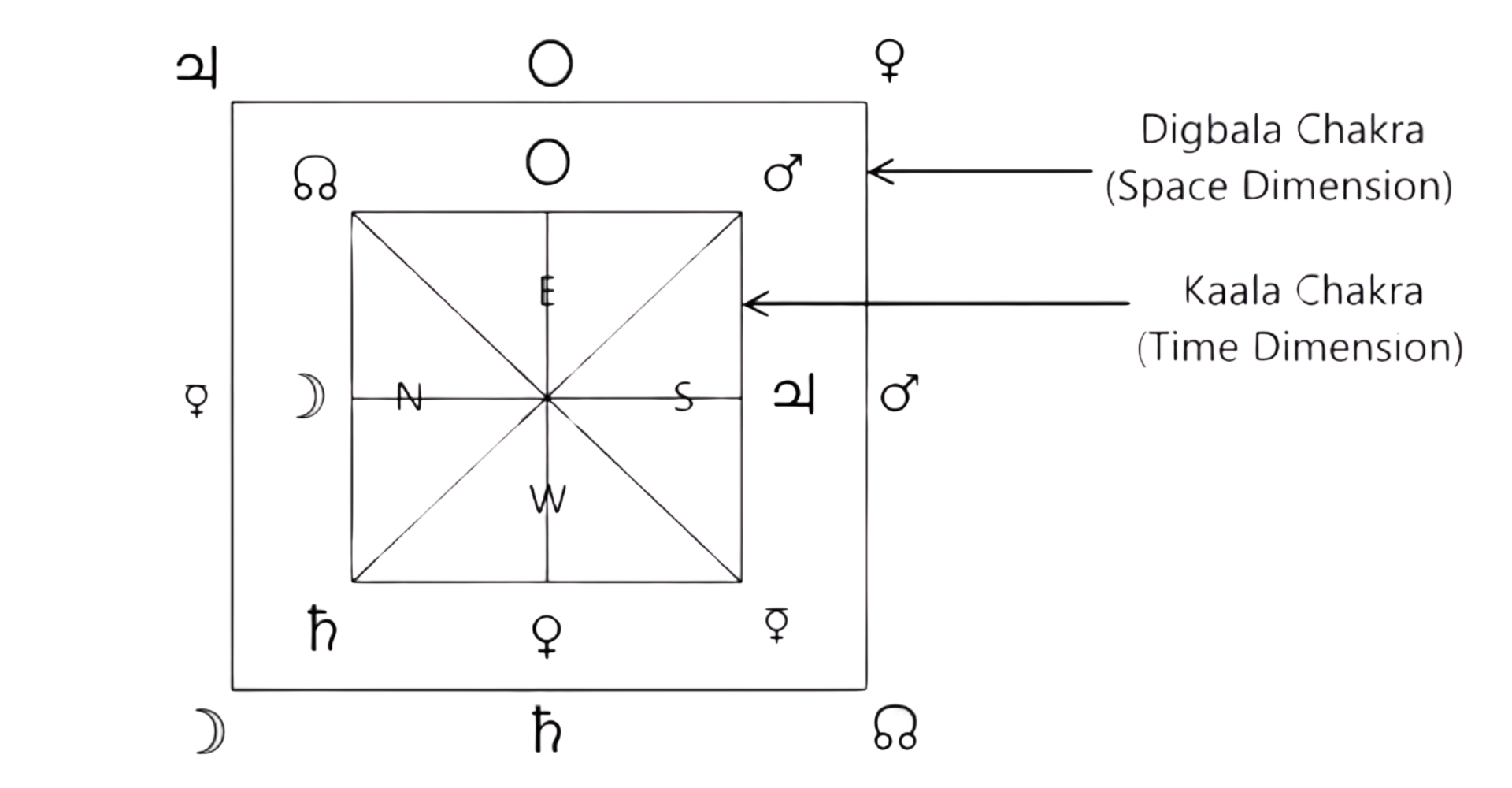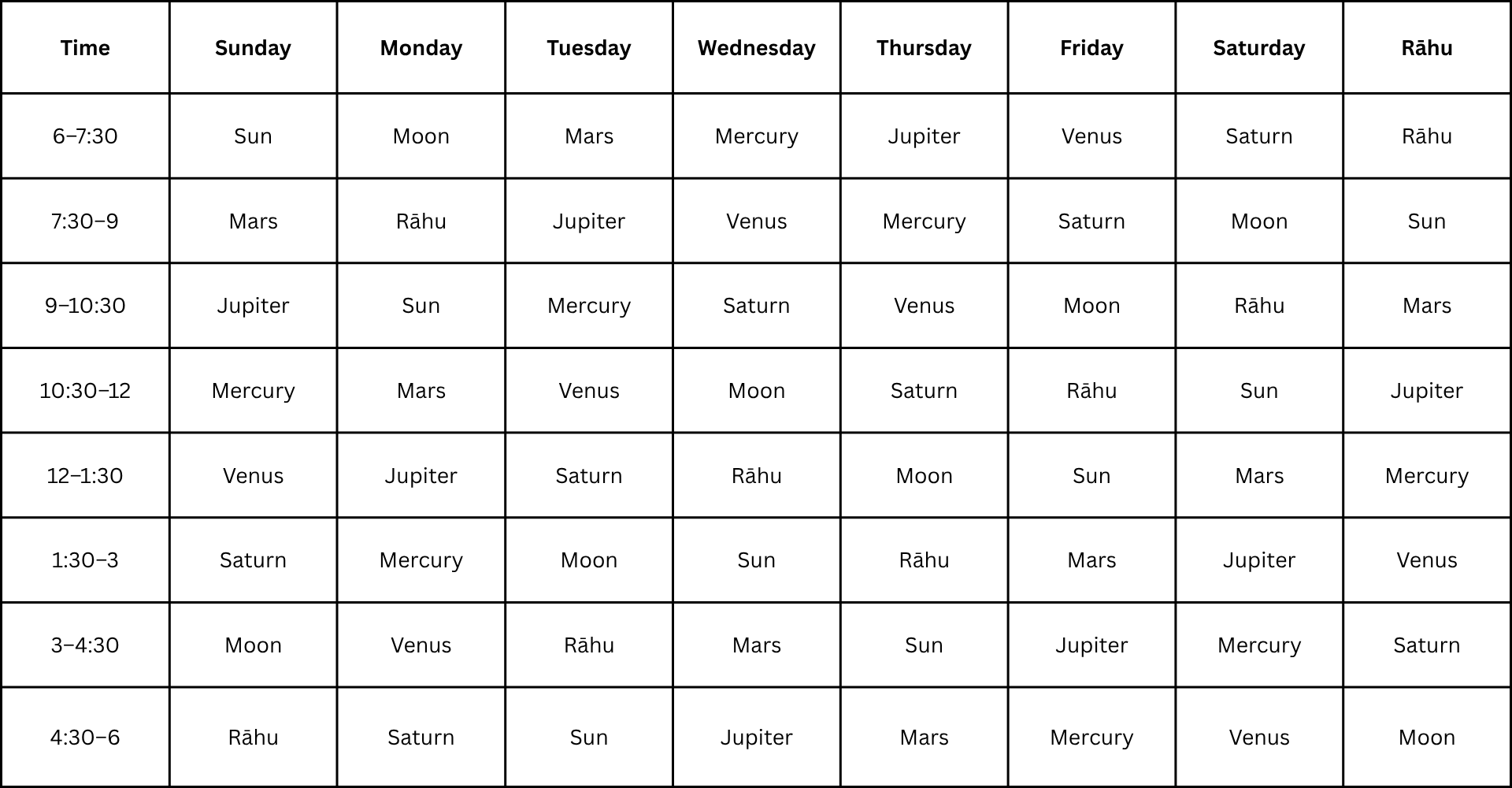Timing Puja with the Kālachakra:
Timing is everything. Just as the stars and planets mark the celestial rhythm of life, every ritual, prayer, and remedial practice (upāya) gains or loses potency depending on when it is performed. One of the most profound—and lesser-known—methods for choosing auspicious timing is the Kālachakra, or “Wheel of Time.”
This sacred system maps the subtle interplay of planetary energies across directions, hours, and elements of the day and night. When used consciously, it can help us perform pujā or upāya at moments when the cosmos most supports transformation.
The Kālachakra: The Eight-Petaled Lotus of Time
The Kālachakra is visualized as an aṣṭa-padma, an eight-petaled lotus. Each petal corresponds to one of the eight cardinal and intermediate directions—Northeast, East, Southeast, South, Southwest, West, Northwest, and North. Each direction has its own deity (dikpāla) and is ruled by a planet (graha), revealing a profound energetic structure through which time flows.
Interestingly, the directional rulers (digpatis) in the Kālachakra differ from those in the standard Digchakra (directional chart). This is because the Kālachakra expresses not the external spatial order of the universe, but the internal, temporal rhythm—the way planetary energies unfold in time and consciousness.
Planetary Symbolism in the Kālachakra
Each planetary placement in the Kālachakra reveals a subtle alchemy—the way one planetary force overcomes or balances the challenges of another.
Northeast (Rāhu / Jupiter): The wisdom of Jupiter overcomes the confusion of Rāhu. Here, higher knowledge (Īśāna consciousness) dispels illusion.
East (Sun / Sun): The Sun, worshipping Indra, signifies rulership balanced by humility. The ego (ahaṃkāra) is refined by ātma-jñāna, self-awareness.
Southeast (Mars / Venus): Venus, ruling the creative fire of Agni, subdues Mars’ aggression with beauty and love.
South (Jupiter / Mars): Mars, ruled by Yama, channels disciplined action to activate Jupiter’s wisdom in the world.
Southwest (Mercury / Rāhu): Mercury tempers Rāhu’s chaos with intelligence and discernment, transforming obsession into inquiry.
West (Venus / Saturn): Venus, worshipping Varuṇa, harmonises Saturn’s austerity with devotion, music, and beauty.
Northwest (Saturn / Moon): The Moon nourishes Saturn’s rigidity, bringing breath, flow, and renewal to what has become hardened.
North (Moon / Mercury): Mercury stabilises the emotional fluctuations of the Moon with clarity, logic, and grounded communication.
This wheel is not merely symbolic—it reflects the living current of time. Each planetary pairing shows how one aspect of our psyche or karma can harmonise with another.
The Science of Puja Timing
Every upāya—whether mantra, charity, fasting, or ritual—can be strengthened when done during the period when the planetary energies that heal its affliction are naturally active.
For example:
To pacify Mars, whose nature is fiery and impatient, one performs pujā during Venus’ active time—invoking love, softness, and artistic flow to dissolve aggression.
To calm Saturn’s heaviness or fear, one may align practice with the Moon’s cycle or the lunar hour, inviting nourishment and emotional balance.
Understanding the Sixteen Kālas
Time itself is divided into 16 kālas—eight in the day and eight at night—each lasting 1.5 hours. The first kāla of the day always begins at 6:00 a.m., regardless of sunrise. The planetary sequence proceeds clockwise around the Kālachakra, beginning with the ruler of the day.
Choosing Your Weekly Puja Time
The ideal time to perform a weekly pujā or upāya is during the kāla ruled by the afflicted planet—on the weekday ruled by its dispositor (the planet that owns its sign).
For example:
If your Moon is in Aries, ruled by Mars, perform your Moon Puja on Tuesday (Mars’ day) during Moon Kāla (1:30–3:00 PM).
If Jupiter is in Capricorn, ruled by Saturn, perform Guru Puja on Saturday during Jupiter Kāla (1:30–3:00 PM).
This simple yet profound method ensures that your remedy aligns with both the planetary and directional forces active at that time.
The Inner Purpose of Timing
TThe Inner Purpose of Timing
The Kālachakra doesn’t simply tell us when to light a lamp—it teaches us how to move in rhythm with the universe. Each kāla is a living pulse of divine intelligence, a breath of cosmic time that beats within and around us. When we align our pujā, our meditation, and even our daily actions with these pulses, our prāṇa becomes refined, and our awareness becomes attuned to dharma.
The sages describe time itself through the story of the Sun’s two sons. From his wife Sañjñā, the Sun had a son named Yama, the lord of death and righteousness. Yama measures time from sunrise, following the outer rhythm of day and night. His is the visible, moral order of the cosmos—the time of the living world, the measure of duty and consequence.
But from Chāyā, the shadow of his wife, the Sun had another son—Kāla, the lord of time itself. Kāla does not depend on sunrise or sunset; he moves independently, governing the inner dimension of time—the subtle current of transformation, karma, and consciousness that flows beneath ordinary awareness.
To walk the path of dharma, we must honor both:
Yama, who measures the outer rhythm of light and darkness, action and consequence; and
Kāla, who governs the inner rhythm of evolution, the unfolding of karma beyond what the eye can see.
When we understand both aspects of time—the visible and the invisible—every ‘ritual’ becomes an opportunity to realign with the sacred order of the cosmos, to move from mechanical performance to conscious participation in the living rhythm of the universe.




